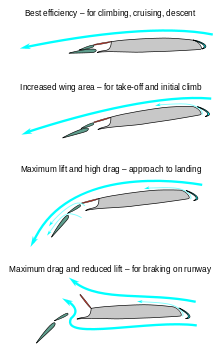Wikijunior:How Things Work/Airplane Wing
| This Wikijunior article is a stub. You can help Wikijunior by expanding it. |
The wing is the part of airplane that enables it to rise into the air.
Who invented it?
[edit | edit source]Many people tried to invent a wing that would let people fly. Even the famous inventor, Leonardo da Vinci drew up plans for different ways of flying with wings like a bird. The first wing that let a person fly was in ancient China in the year 559. It was really just a large kite. In 877, long before Marco Polo and other explorers brought back information about Chinese kites to Europe, an Arab inventor in Spain named Abbas Ibn Firnas made the first hang glider, and tested it himself.
Sir George Cayley and later Otto Lilienthal created working gliders that allowed people to fly as long ago as the 1800s. The Wright Brothers were famous for the airplane that they first demonstrated in 1903 in Kitty Hawk, North Carolina, but their airplane's wings worked in the same way as Otto Lilienthal's glider wings from 1891.
How does it get power?
[edit | edit source]The only power that a wing needs is to be moved forward through the air. In a glider the wing is either pushed to get it started, or it is brought somewhere high up and dropped, like a hang glider pilot starting from the top of a cliff. In a powered airplane, the engines either push or pull the wings through the air.
The shape and positioning of a wing is very important. Most wings are curved, which makes the air going over them go faster than the air going under them. Because the air above the wing moves faster, it is more spread out than the air below the wing. Air presses on everything around it, even though you can't feel it. When there is more air it pushes more on the things around it. The fast-moving, spread-out air over the top of the wing lets the air on the bottom of the wing push the wing up, creating lift.
Another way to think of it is that the wing of an airplane is usually tilted so that the front is higher than the back. The air that follows the upper and lower surfaces of the wing is directed downward by the wing's shape and tilt. This creates an opposing upward lifting force on the wing itself. It is the lift from the wings that carries a plane through the air.
How dangerous is it?
[edit | edit source]Airplane wings are not dangerous. Airplanes themselves have a good safety record when they are well maintained and handled. Wings are as dangerous as any fast moving object can be and so depends also on the material it is made. First planes were made of very flimsy material because of weight and wings strength evolved accordingly to the speed requirements, the faster the plane the stronger the material must be.
What does it do?
[edit | edit source]
A wing is a part of airplane that lifts it up. There are mainly four forces acting on airplane while in air. Wings provide the force to the airplane that takes it up against the force of gravity due to earth. An airplane wing is specially designed so that air that passes around it actually helps lift up the plane. It is also streamlined in shape so that the plane can move at maximum speed.
The horizontal 'front' or 'leading edge' splits the air so that the airstream over the top of the wing has to travel further than the airstream beneath the wing. When the two streams meet again at the 'trailing edge' the upper airstream has been stretched and the lower airstream has been compressed. The wing tries to equalize the air pressure above and below by moving up, but of course it can not move upwards without also lifting the airplane!

The reason an airplane is so called is because each wing provides two flat surfaces or planes which are joined by a thick, almost semicircular leading edge, and which meet at the sharp trailing edge. Because they split the air wings are properly called Aero-planes or (mostly in the USA) airplanes. Helicopter blades and propellers also technically possess 'airplanes' but today for most people who are not aviation specialists or 'aerodynamicists' the term simply means the complete 'fixed wing aircraft'
Wing shape can be modified to increase or decrease lift using flaps and ailerons
How does it vary?
[edit | edit source]All airplane wings contain flaps to increase lift and drag. Some airplane wings, especially those of larger jets, have spoilers that will further slow down the airplane. This is important in landing, where one must land at the slowest speed possible without stalling and then stop the airplane's movement as quickly as possible.
In larger airplanes the wings often have the engines fixed onto them.
How has it changed the world?
[edit | edit source]An airplane wing is one of the most fundamental things that allow a plane to fly. Without it, a plane does not fly and it has brought planes all over the world.
What idea(s) and/or inventions had to be developed before it could be created?
[edit | edit source]The first plane had to be invented before any experimentation with the wing could occur. The earliest wings were simply light framed wooden planks, with no such inbuilt drag or lift functions.
References
[edit | edit source]| This Wikijunior article is a stub. You can help Wikijunior by expanding it. |
